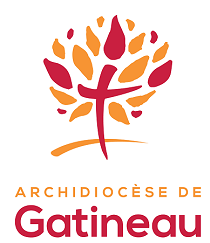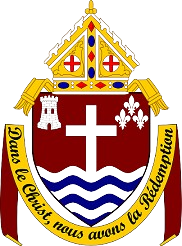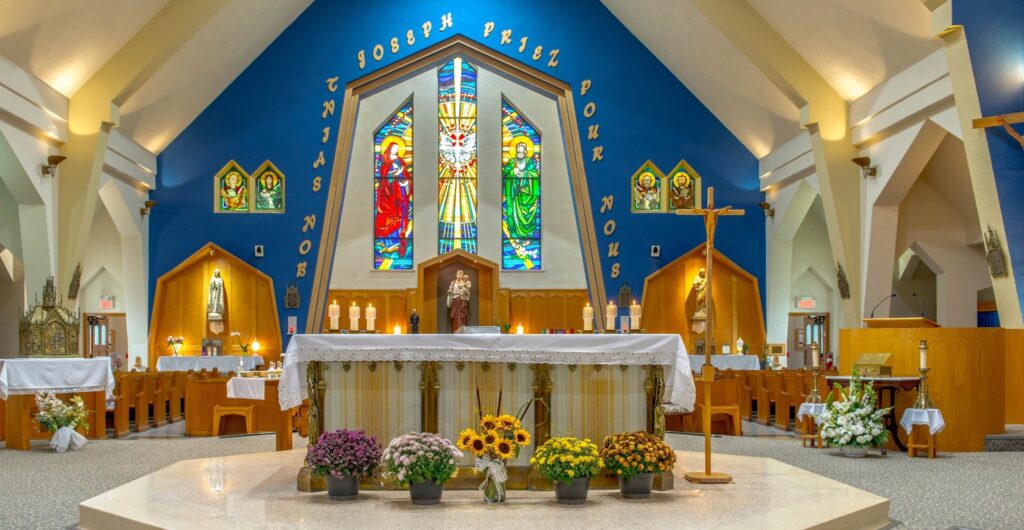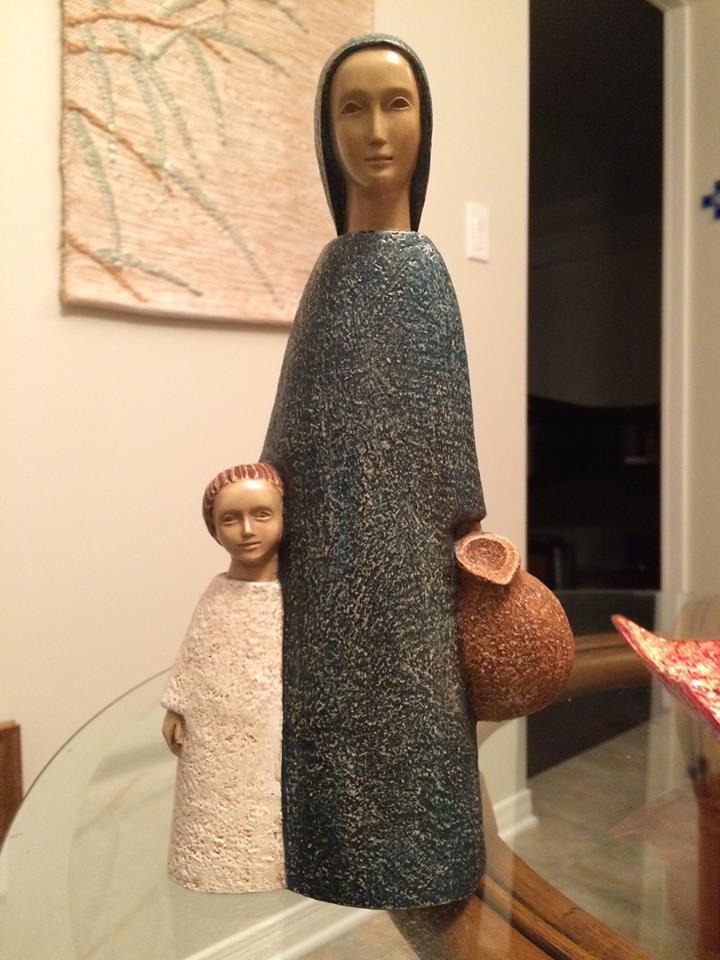The Archdiocese of Gatineau is one of the 21 constituencies of the Roman Catholic Church in Quebec (61 across Canada). Founded in 1963 by separation from the Archdiocese of Ottawa, it covers almost the entire administrative region of the Outaouais. It includes 51 places of worship, most of which are in French, some in English and two in Portuguese. (Note that Mass is also celebrated in Spanish at St. Joseph’s Cathedral.) The items in this section will help you learn more about our reality.
Statistics 2023
The territory of the Archdiocese of Gatineau includes the MRC de Papineau, the city of Gatineau and several surrounding municipalities. The resident population is 291,041.
| Paroisses : 57 | Prêtres de 1 paroisse : 8 | Prêtres dans le diocèse : 55 |
| Dessertes/Missions : 7 | Prêtres de 2 paroisses : 7 | Prêtres d’Institut séculier : 1 |
| Ass. publiques de fidèles : 2 | Prêtres de 3 paroisses : 5 | Prêtres diocésains en paroisse : 14 |
| Unités pastorales : 5 | Prêtres de 4 paroisses : 2 | Prêtres religieux en paroisse : 20 |
| Zone anglophone : 1 | Prêtre de 5 paroisses : 1 | Prêtres diocésains retraités : 19 |
| Prêtre de 12 paroisses : 2 | Prêtres incardinés dans le diocèse : 23 | |
| Prêtres diocésains provenant de l’étranger : 22 | ||
| Prêtres décédés : 1 | ||
| Diacres permanents : 4 |
For all parishes and services in the Diocese of Gatineau, there were :
Baptisms: 607
First Communions: 271
Confirmations: 242
Marriages : 109
Funerals : 1,243 – In parishes: 518 – Gardens of remembrance: 725
Burials: 853 – In parishes: 554
Explanations of the logo

- The diocesan logo was originally created in 1991. Since then, it has been refreshed a few times. It acts as the public signature of our diocesan Church and helps create a sense of belonging among all the faithful of the region.
- The stylized tree represents the Tree of Life.
- The tree also makes a link with the Outaouais region, where the lumber industry played a very important part in its history.
- The cross is the symbol of the Christian faith, and is a unifying symbol.
- The flames of the burning bush symbolize the parishioners, the parishes and the pastoral units. Together, the flames form a strong and united Church: the diocesan Church of Gatineau.
- The flames also represent a movement towards the outside, towards the Outaouais community. The Church of Gatineau is there to proclaim the Gospel, and help us strengthen our faith in Jesus.
- The 7 red flames, (black in the black-and-white version), represent the 7 days of the week, and the 12 orange flames, (gray in the black-and-white version), represent the 12 months of the year.
- The numbers 7 and 12, in the Bible, respectively represent the spiritual plenitude (Lev. 4: 6; Heb. 2: 4), the 12 tribes of Israel, and the 12 Apostles.
Explanation of the diocesan coat of arms
- The coat of arms dates from the foundation of the diocese in 1963.
- Logo: In Christ, we have Redemption.
- Cross: Symbol of Redemption.
- Three fleur-de-lis: Represent the Province of Quebec.
- Tower: Symbol of our French ancestry
- Wavy lines: Represent the Ottawa River

The Cathedral

The cathedral is the proper church of the diocesan bishop. In this sense, it is the mother-church of the diocese, the gathering place for the major celebrations that mark diocesan life. It derives its name from the bishop’s chair, known as the « cathedra ». This seat is a tangible sign of the the unity of the faithful in a given region who share the one faith taught by the bishop as shepherd of his flock. Saint Joseph is the titular saint of the cathedral of the archdiocese of Gatineau. It is situated at 245 boulevard St-Joseph in this same city. It is characterized by its unique layout (the pews surround the sanctuary from all sides) and its beautiful stained glass windows depicting the cycle of the Nativity, the cycle of the Paschal mystery and the patron saints of the archdiocese.
Our Diocesan Patron – Mary, Mother of the Church
The Blessed Virgin Mary, Mother of the Church
Pope Paul VI used this expression in the promulgation of the encyclical Lumen Gentium: “It is therefore to the glory of the Blessed Virgin and to our comfort that we proclaim Mary Most Holy, Mother of the Church. “At the closing address of the Second Vatican Council on 7 December 1965, Paul VI repeated the title “Mother of the Church”. With this solemn act of the supreme magisterium, the Pope wanted to affirm “the maternal function wich the Virgin Mary exercises towards the Christian people. He thus wished, as the Council requested, to promote the “filial piety” of all the members of the Church towards the Mother of Jesus, who was givin to us as our mother when Jesus, on the cross, said to John: « Behold your mother ».

The perfect disciple of Jesus, and a living incarnation of the Beatitudes Mary is the perfect model of the disciple of the Lord: the disciple who builds up the earthly and temporal city while being a diligent pilgrim towards the heavenly and eternal city; the disciple who works for that justice which sets free the oppressed and for that charity which assists the needy; but above all, the disciple who is the active witness of that love which builds up Christ in people’s hearts. (Paul VI, Marialis cultus, n. 37)
Mary, Mother of the Church, is the patroness of our diocese. It has been decided that her feast be celebrated on October 11 in the liturgical calendar of our diocese, even though this date remains a holiday in the universal calendar. A little bit of history can help explain this choice.
In 1931, Pope Pius XI instituted the feast of the « Divine Maternity of Mary » in commemoration of the fifteen hundredth anniversary of the opening of the Council of Ephesus that had declared Mary to be the Mother of God. Pope John XXIII chose this same date to open the Second Vatican Council in 1962, placing the Council under the protection of the Blessed Virgin.
In 1974, when the liturgical calendar of the Universal Church was reorganized, Pope Paul VI moved the feast of the Maternity of Mary from October 11 to January 1, under the title «Mary, Mother of God», thus returning to an ancient Roman tradition.
In choosing to celebrate the feast of Mary, Mother of the Church on October 11, our diocese commemorates the opening of the Second Vatican Council, as well as its own foundation during this same Council, on April 27th, 1963. From the very beginning, our diocese has been shaped by the primary orientations of Vatican II which is for us an inalienable treasure and an always active source of life. Beyond all questions of structures or laws, Mary brings us back to the intimate and essential core of the Church, for she is our mother in the order of grace, of our relationship with Jesus, of faith, of hope and of love.
In 2018, Pope Francis instituted the Memory of the Virgin Mary, Mother of the Church on the first Monday after Pentecost. This decree was signed on February 11.
The Blessed Virgin Mary, Mother of the Church being our main patroness, we can celebrate Her Feast on October 11th, except when the it falls on a Sunday.

